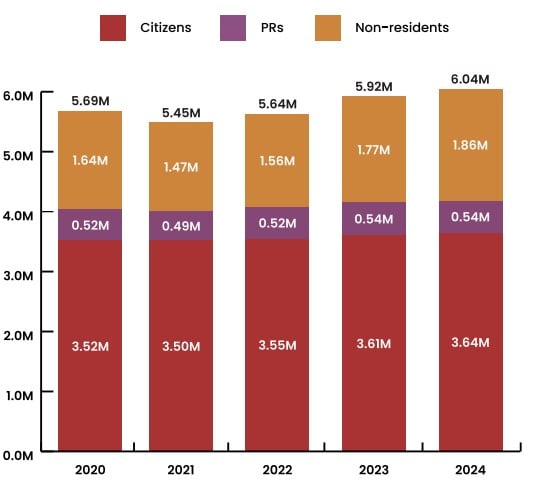S’pore population now more than 6 million but likely to be significantly below 6.9 million by 2030
Singapore’s population is now at 6.04 million, having exceeded the six million mark for the first time in the nation’s history.
The increase was driven mainly by non-residents, the number of which went up by 5%.

6 million population is 2% rise from 2023
The latest population figures, correct as of June 2024, were released by the National Population and Talent Division (NPTD) on Tuesday (24 Sept).
They were revealed in the annual Population In Brief report, which updates Singapore’s key population trends.
It said Singapore’s population of 6,036,900 represented a 2% rise from June 2023, when it was 5,917,600.
It’s also the third straight year of population increase since 2021, when the population decreased due to the Covid-19 pandemic.
6 million population includes 1.856 million non-residents
The total population in 2024 comprises 4,180,900 residents and 1,856,000 non-residents.
Non-residents are made up of Singapore’s foreign workforce, migrant domestic workers, dependants and international students.
The resident population can be split into 3,635,900 citizens and 544,900 permanent residents (PRs).
Rise in all population categories
There was a rise in all population categories, the report also indicated.
The number of citizens increased by 0.7%, while the PR population rose by 1.2%.

However, the non-resident population jumped by the highest percentage of 5%.
This increase was seen across “most pass types”, the report said.
Non-resident population increase mainly due to foreign employment
The report noted that the increase in the non-resident population was mainly due to foreign employment growth.
Accordingly, Work Permit holders contributed most to the increase (44%), followed by migrant domestic workers (15%).
The size and composition of the non-resident population fluctuate depending on Singapore’s “economic and social needs”, with the foreign workforce currently making up two-thirds, the report said, adding:
As Singapore is fundamentally labour constrained, the foreign workforce complements our local workforce and allows companies to access a broader range of skills from the global labour pool.
On top of that, Singapore’s annualised population growth rate over the last five years (2019 to 2024) was 1.1%, slightly higher than 0.8% over the previous five years (2014 to 2019).
This was mostly due to the disruption caused by the pandemic, which caused a growth in the number of Work Permit Holders after the pandemic in certain sectors as companies attempted to catch up on delayed projects.
S’pore population likely lower than 6.9M by 2030
Additionally, NPTD said that Singapore’s total population will likely be “significantly” below 6.9 million by 2030.
That figure was used in a Population White Paper released in 2013 which projected that Singapore’s population would reach up to 6.9 million by 2030.

After the figure caused disquiet among Singaporeans, an amended motion of the White Paper was adopted stating that 6.9 million was not a target.
There have also been clarifications over the years that the population would likely be significantly below 6.9 million by 2030, given trends.
In February 2023, Minister in the Prime Minister’s Office Indranee Rajah said during a Committee of Supply debate that the Government does not plan on a single population planning parameter, adding:
Instead, increasingly we develop various scenarios to stress-test our assumptions and allow for a range of possible outcomes.
Based on these scenarios, the planning parameter of 6.9 million remains relevant for the 2030s, NPTD said.
Also read: 18.4% Of S’poreans Are Aged 65 & Above, Population Ageing Faster Than In Previous Decade
18.4% Of S’poreans Are Aged 65 & Above, Population Ageing Faster Than In Previous Decade
Have news you must share? Get in touch with us via email at news@mustsharenews.com.
Featured image by MS News.










